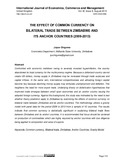Please use this identifier to cite or link to this item:
https://cris.library.msu.ac.zw//handle/11408/657Full metadata record
| DC Field | Value | Language |
|---|---|---|
| dc.contributor.author | Chigome, Joyce | - |
| dc.date.accessioned | 2015-09-14T09:08:13Z | - |
| dc.date.available | 2015-09-14T09:08:13Z | - |
| dc.date.issued | 2015-08 | - |
| dc.identifier.other | ESSN: 2348-0386 | - |
| dc.identifier.uri | http://hdl.handle.net/11408/657 | - |
| dc.description.abstract | Confronted with economic meltdown owing to severely invested hyperinflation, the country abandoned its local currency for the multicurrency regime. Because a dollarized country cannot create US dollars, money supply in Zimbabwe may be increased through trade surpluses and capital inflows. In the same vein, international competitiveness and attracting foreign capital become key because declining money supply may stimulate unemployment and deflation. This heightens the need for more export trade. Underlying theory on dollarization hypothesizes that improved trade emerges between small open economies and an anchor country issuing the adopted foreign currency. Against this background, the study was motivated by the need to test whether theory prediction apply to Zimbabwe by examining the effects of common currency on bilateral trade between Zimbabwe and its anchor countries. The methodology utilizes a gravity model with panel data for the period 2009 to 2013 from a sample of 12 countries. The results indicate that common currency is statistically significant in explaining bilateral trade flows between Zimbabwe and its anchor countries. It is recommended that focus should be centered on production of commodities which are highly required by anchor countries with due diligence being applied to composition and value of exports. | en_US |
| dc.language.iso | en | en_US |
| dc.publisher | IJECM | en_US |
| dc.relation.ispartofseries | International Journal of Economics, Commerce and Management;Vol. 3, Issue 8 | - |
| dc.subject | Common currency, bilateral trade, Zimbabwe, anchor countries, gravity model | en_US |
| dc.title | The effect of common currency on bilateral trade between Zimbabwe and its anchor countries (2009-2013) | en_US |
| dc.type | Article | en_US |
| item.openairetype | Article | - |
| item.fulltext | With Fulltext | - |
| item.languageiso639-1 | en | - |
| item.grantfulltext | open | - |
| item.openairecristype | http://purl.org/coar/resource_type/c_18cf | - |
| item.cerifentitytype | Publications | - |
| Appears in Collections: | Research Papers | |
Files in This Item:
| File | Description | Size | Format | |
|---|---|---|---|---|
| common currency.pdf | 541.56 kB | Adobe PDF |  View/Open |
Items in MSUIR are protected by copyright, with all rights reserved, unless otherwise indicated.



